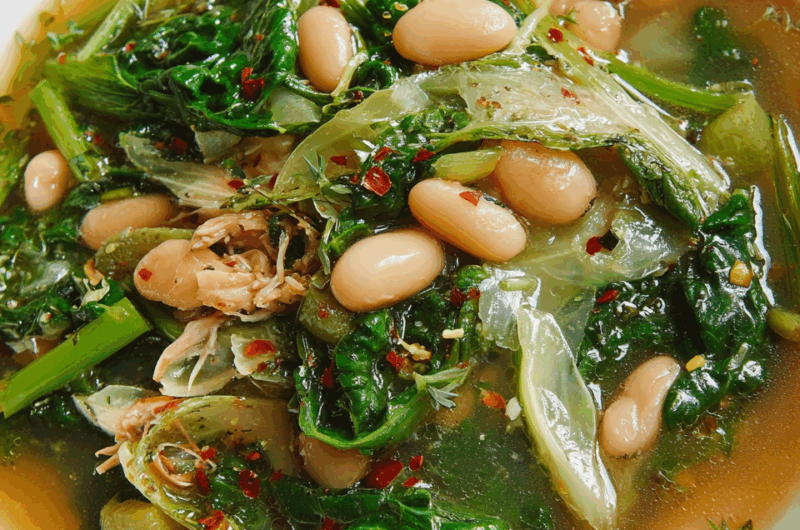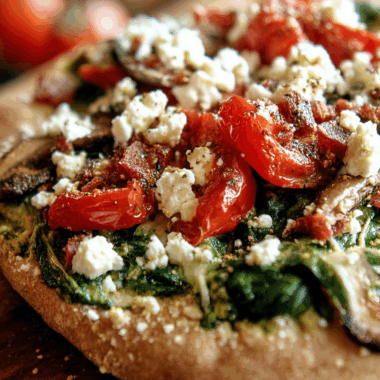This humble yet delicious Tuscan-style beans and greens dish is a celebration of simple ingredients elevated by great technique. Cannellini beans simmered with fragrant garlic, a touch of red pepper, and a savory hint of anchovy come together in a rich, reduced chicken broth. Escarole, a slightly bitter green, perfectly complements the creamy beans for a flavor profile that’s hearty and nourishing.
Whether served as a cozy appetizer or a comforting main with some crusty bread, this dish is satisfying without being heavy. The beauty lies in its versatility—you can dress it up with sausage or keep it vegetarian. Either way, it’s a soul-soothing meal perfect for chilly evenings or when you just need a warm, homemade touch.
Full Recipe:
-
2 tablespoons olive oil
-
4 cloves garlic, thinly sliced
-
4 cups chicken broth
-
2 pinches red pepper flakes, divided
-
2 (15 ounce) cans cannellini (white) beans, drained
-
1 anchovy fillet
-
2 teaspoons chopped fresh oregano
-
½ teaspoon lemon zest
-
1 head escarole, chopped
-
Salt and ground black pepper to taste
-
1 tablespoon extra-virgin olive oil
Directions:
-
Heat olive oil in a saucepan over medium heat. Add the garlic and sauté until just bubbling and fragrant, about 20 seconds.
-
Pour in the chicken broth and bring it to a boil. Simmer until the liquid reduces by half, 6–8 minutes. Stir in a pinch of red pepper flakes.
-
Add the cannellini beans and bring to a boil again. Cook until the tops of the beans are just visible beneath the broth, 6–8 minutes.
-
Stir in the anchovy fillet, oregano, and lemon zest. Let simmer for 3 minutes.
-
Add chopped escarole and reduce heat to low. Stir and cook until the escarole wilts, about 5 minutes.
-
Season with salt and pepper. Finish with a drizzle of extra-virgin olive oil and a second pinch of red pepper flakes.
Prep Time: 10 minutes | Cooking Time: 20 minutes | Total Time: 30 minutes
Kcal: 203 kcal | Servings: 6 servings
Introduction to Beans and Greens
Chef John’s Beans and Greens is more than just a recipe—it’s a celebration of simplicity, comfort, and Italian-American culinary tradition. This dish masterfully blends pantry staples like cannellini beans and garlic with the freshness of escarole, all simmered in a rich, flavorful broth. While it might appear modest at first glance, this one-pot wonder packs in bold flavors, satisfying textures, and wholesome nutrition.
Whether you’re a seasoned home cook or just beginning your journey in the kitchen, this dish is approachable, quick to prepare, and endlessly versatile. It can be served as a hearty appetizer, a warming main course, or even a side dish. What’s most beautiful about Beans and Greens is that it offers nourishment for both the body and soul, evoking a sense of home with every spoonful.
The Story Behind the Dish
“Beans and greens” has deep roots in Southern Italian and Italian-American kitchens. Traditionally, this dish came from the cucina povera, or “kitchen of the poor,” where resourceful home cooks created deeply satisfying meals using inexpensive, accessible ingredients. Leafy greens like escarole, dandelion, or kale would be harvested from gardens or local markets, while beans provided affordable protein and substance.
Chef John’s version honors these origins while offering a polished, modern interpretation. By reducing the broth for concentrated flavor and adding nuances like anchovy and lemon zest, this rendition elevates humble ingredients into something restaurant-worthy without losing its rustic charm.
Why Escarole Is the Star
While many leafy greens could serve the role, escarole brings a delicate bitterness that balances beautifully with the creamy beans and savory broth. Part of the chicory family, escarole resembles a frilly head of lettuce but offers a sturdier texture and a slightly peppery, earthy flavor.
Cooking escarole softens its bite, making it a perfect companion to white beans. Unlike spinach or kale, it holds its structure in hot broth, offering both visual appeal and toothsome satisfaction. It’s a green that welcomes seasonings and takes on layers of taste—especially when enhanced with garlic, red pepper flakes, and a drizzle of good olive oil.
Cannellini Beans: Creamy and Satisfying
Cannellini beans are a classic Italian pantry staple and a central component of this dish. These white beans are known for their creamy texture and mild, nutty flavor. In this recipe, they absorb the rich broth and aromatics, becoming little flavor sponges that burst with umami in every bite.
Not only are they tasty, but cannellini beans are packed with fiber, protein, and essential minerals. They help make this dish as filling as it is healthy, supporting everything from digestive health to blood sugar regulation.
Flavor Building Techniques
Chef John’s method stands out for its culinary technique, particularly the reduction of chicken broth and the layering of aromatics. Starting with sautéed garlic in olive oil, he quickly infuses the base with a warm, pungent aroma. The reduction of chicken broth isn’t just for thickness—it concentrates the savory, meaty notes, creating a more robust and flavorful soup base.
A surprising addition is the anchovy fillet. While some might be hesitant, anchovy doesn’t make the dish “fishy.” Instead, it melts into the broth, adding a depth of umami that’s subtle but irreplaceable. Paired with lemon zest and oregano, it brings a vibrant lift that balances the richness of the beans and broth.
A Perfect Example of Nutritional Balance
Beans and Greens might be humble, but it’s a powerhouse of nutrition. Each serving delivers a healthy balance of macronutrients—protein, fiber, and healthy fats—along with essential vitamins and minerals. Escarole contributes vitamin K, folate, and vitamin A, while the beans offer iron, magnesium, and complex carbs.
With a moderate calorie count of around 200 per serving, it’s light enough for lunch but hearty enough for dinner. It’s also easy to modify based on dietary needs: swap in vegetable broth and omit the anchovy for a vegetarian version, or include sausage or pancetta for added richness and protein.
Serving Suggestions and Pairings
While delicious on its own, Beans and Greens pairs beautifully with rustic accompaniments. A thick slice of toasted sourdough or crusty Italian bread makes for the perfect dunking tool. You can also serve it with polenta or alongside a simple salad with citrus vinaigrette to contrast the richness.
For a more filling meal, serve this dish with grilled sausages or roasted chicken. If you’re going plant-based, consider adding a scoop of cooked farro or barley to the soup for extra texture and nutrition. A splash of red wine vinegar or a grating of Parmesan cheese at the table can enhance the flavors even further.
Customizing the Recipe
Part of what makes Beans and Greens a kitchen staple is its adaptability. Chef John’s method is a starting point for creativity. Don’t have escarole? Try kale, Swiss chard, collards, or even mustard greens. No cannellini beans? Great Northern or navy beans make excellent substitutes.
Home cooks frequently personalize this recipe by adding extras like chopped onions, pancetta, sausage, or even a splash of wine. Others opt to make it spicier with additional red pepper flakes or a spoonful of Calabrian chili paste. These variations only expand the appeal and allow you to make the dish truly your own.
Cultural and Culinary Significance
Beans and Greens is a dish that crosses borders—both literal and culinary. In Italy, it’s known as fagioli e verdure, and versions of it can be found in every region, from Tuscany to Naples. In the U.S., it’s a staple of Italian-American households, especially in cities like Buffalo, Pittsburgh, and Cleveland, where many immigrants preserved old-world food traditions.
It’s also a dish that resonates beyond Italian cuisine. Versions of greens and beans appear in Southern cooking (think collard greens and field peas), Middle Eastern stews, and even Japanese and Korean meals where legumes and leafy greens are staples.
That cross-cultural appeal underscores the universal truth of comfort food: it’s not about extravagant ingredients or complicated techniques—it’s about warmth, sustenance, and care.
Beans and Greens as a Year-Round Staple
Although often associated with colder months, this dish transitions well throughout the year. In winter, it’s cozy and warming. In spring, it offers a fresh, green-forward flavor. Escarole can often be found year-round in many grocery stores, and canned beans are always accessible, making it easy to keep the ingredients on hand.
It’s also ideal for meal prep. Make a large pot and store portions in the fridge or freezer. It reheats beautifully and often tastes even better the next day as the flavors continue to develop.
Conclusion: Humble, Hearty, and Timeless
Chef John’s Beans and Greens is proof that a few simple ingredients, when treated with care and technique, can produce a dish that’s comforting, nourishing, and deeply flavorful. It honors tradition while remaining modern and accessible. Whether you’re enjoying it as a weeknight staple, an elegant first course, or a cozy main on a chilly evening, this dish checks all the boxes.
It’s economical without being boring. Nutritious without sacrificing taste. Rustic yet refined. It’s the kind of meal that makes you feel good inside and out, and one that’s easy to pass on to friends and family. Once you try it, you’ll understand why Beans and Greens is a timeless favorite in so many kitchens.








